Abstract
In assessing the distribution and metabolism of toxic compounds in the body, measurements are not always feasible for ethical or technical reasons. Computer modeling offers a reasonable alternative, but the variability and complexity of biological systems pose unique challenges in model building and adjustment. Recent tools from population pharmacokinetics, Bayesian statistical inference, and physiological modeling can be brought together to solve these problems. As an example, we modeled the distribution and metabolism of benzene in humans. We derive statistical distributions for the parameters of a physiological model of benzene, on the basis of existing data. The model adequately fits both prior physiological information and experimental data. An estimate of the relationship between benzene exposure (up to 10 ppm) and fraction metabolized in the bone marrow is obtained and is shown to be linear for the subjects studied. Our median population estimate for the fraction of benzene metabolized, independent of exposure levels, is 52% (90% confidence interval, 47-67%). At levels approaching occupational inhalation exposure (continuous 1 ppm exposure), the estimated quantity metabolized in the bone marrow ranges from 2 to 40 mg/day.
Full text
PDF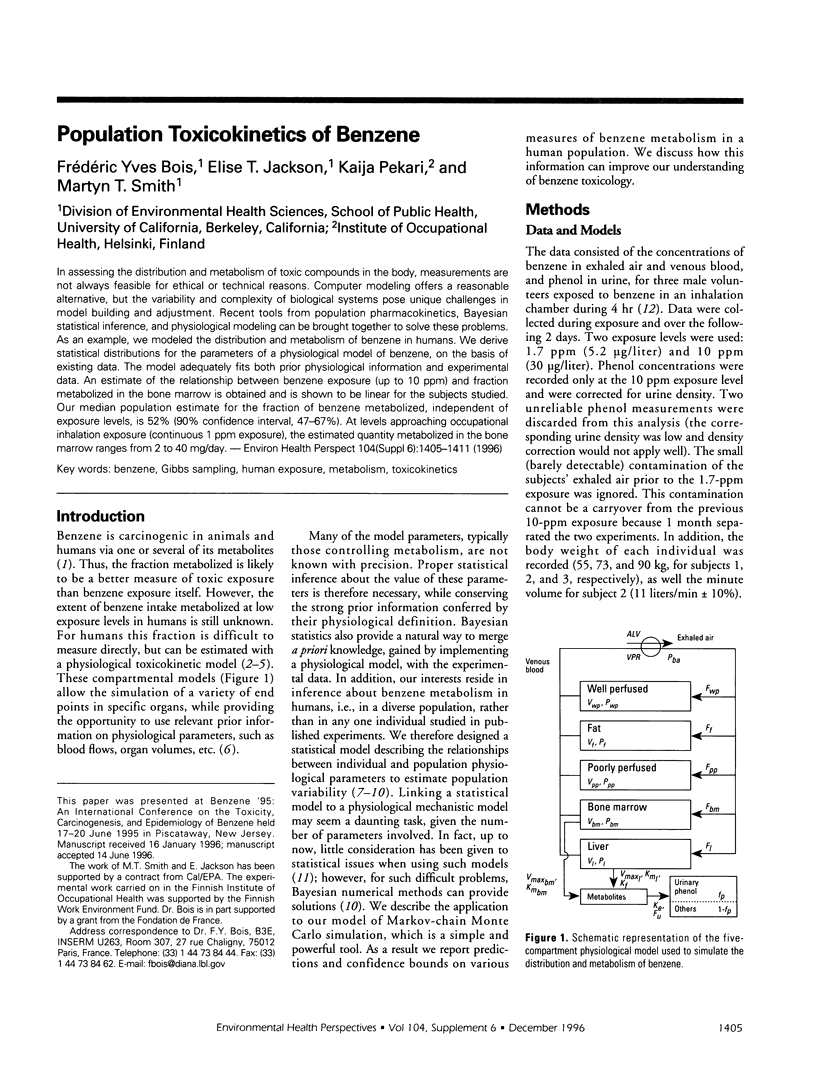
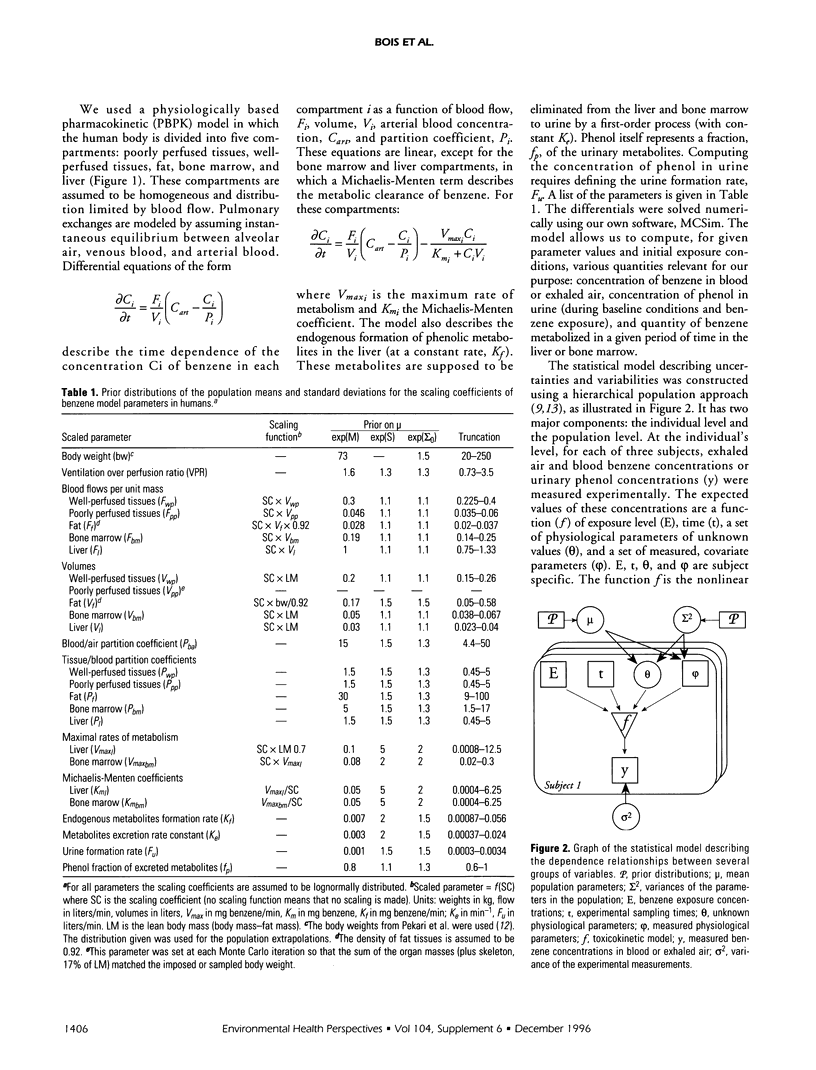
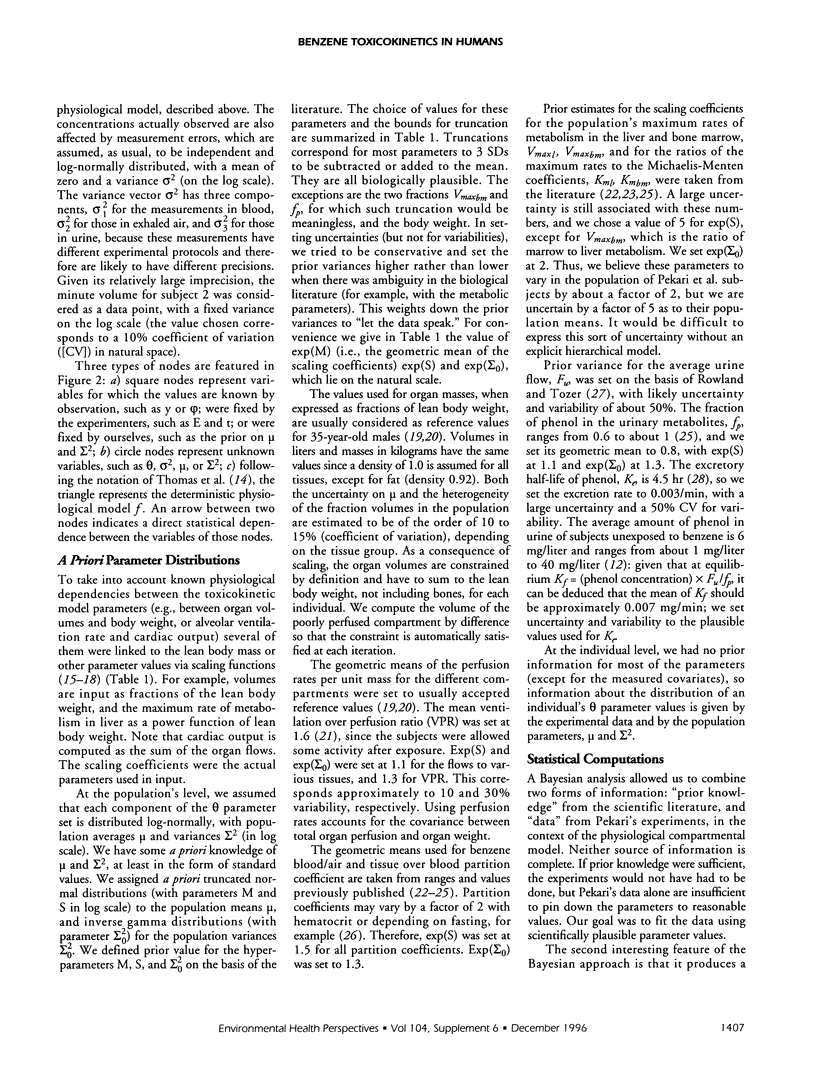
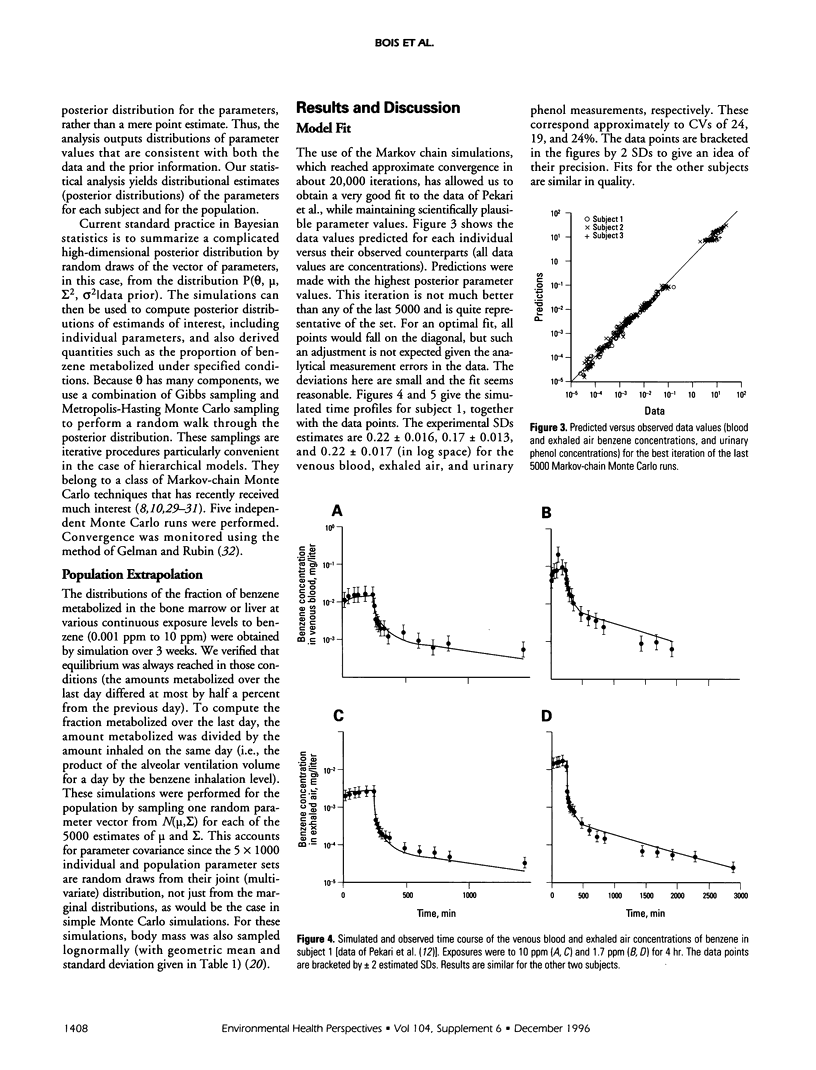
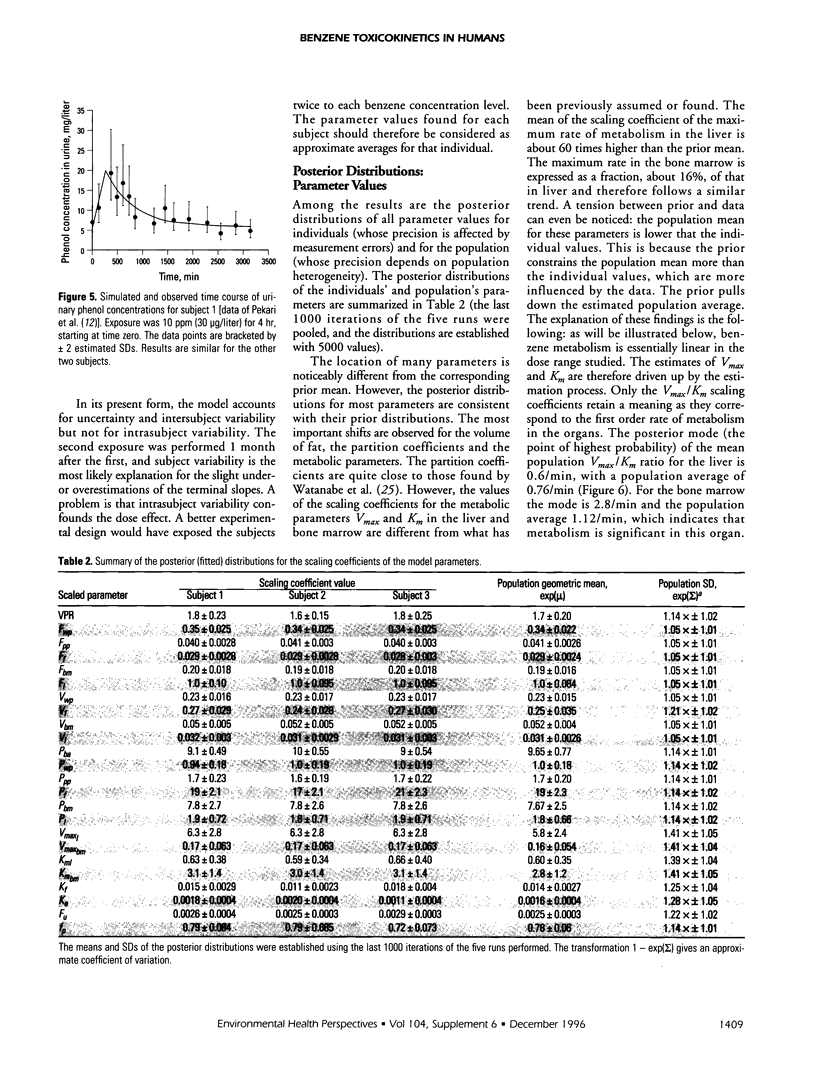

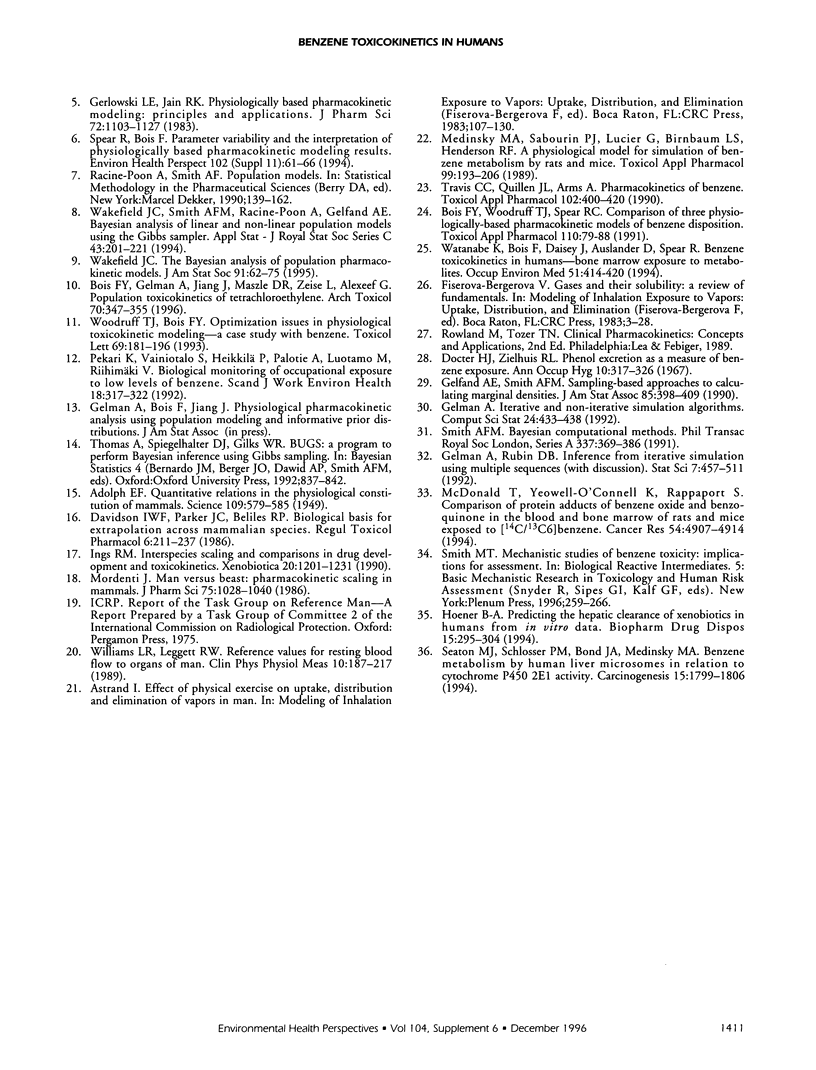
Selected References
These references are in PubMed. This may not be the complete list of references from this article.
- Adolph E. F. Quantitative Relations in the Physiological Constitutions of Mammals. Science. 1949 Jun 10;109(2841):579–585. doi: 10.1126/science.109.2841.579. [DOI] [PubMed] [Google Scholar]
- Andersen M. E., Krewski D., Withey J. R. Physiological pharmacokinetics and cancer risk assessment. Cancer Lett. 1993 Apr 15;69(1):1–14. doi: 10.1016/0304-3835(93)90025-5. [DOI] [PubMed] [Google Scholar]
- Balant L. P., Gex-Fabry M. Physiological pharmacokinetic modelling. Xenobiotica. 1990 Nov;20(11):1241–1257. doi: 10.3109/00498259009046841. [DOI] [PubMed] [Google Scholar]
- Bois F. Y., Gelman A., Jiang J., Maszle D. R., Zeise L., Alexeef G. Population toxicokinetics of tetrachloroethylene. Arch Toxicol. 1996;70(6):347–355. doi: 10.1007/s002040050284. [DOI] [PubMed] [Google Scholar]
- Bois F. Y., Woodruff T. J., Spear R. C. Comparison of three physiologically based pharmacokinetic models of benzene disposition. Toxicol Appl Pharmacol. 1991 Aug;110(1):79–88. doi: 10.1016/0041-008x(91)90291-l. [DOI] [PubMed] [Google Scholar]
- Bois F. Y., Zeise L., Tozer T. N. Precision and sensitivity of pharmacokinetic models for cancer risk assessment: tetrachloroethylene in mice, rats, and humans. Toxicol Appl Pharmacol. 1990 Feb;102(2):300–315. doi: 10.1016/0041-008x(90)90029-t. [DOI] [PubMed] [Google Scholar]
- Davidson I. W., Parker J. C., Beliles R. P. Biological basis for extrapolation across mammalian species. Regul Toxicol Pharmacol. 1986 Sep;6(3):211–237. doi: 10.1016/0273-2300(86)90014-0. [DOI] [PubMed] [Google Scholar]
- Docter H. J., Zielhuis R. L. Phenol excretion as a measure of benzene exposure. Ann Occup Hyg. 1967 Oct;10(4):317–326. doi: 10.1093/annhyg/10.4.317. [DOI] [PubMed] [Google Scholar]
- Gerlowski L. E., Jain R. K. Physiologically based pharmacokinetic modeling: principles and applications. J Pharm Sci. 1983 Oct;72(10):1103–1127. doi: 10.1002/jps.2600721003. [DOI] [PubMed] [Google Scholar]
- Hoener B. A. Predicting the hepatic clearance of xenobiotics in humans from in vitro data. Biopharm Drug Dispos. 1994 May;15(4):295–304. doi: 10.1002/bdd.2510150404. [DOI] [PubMed] [Google Scholar]
- Ings R. M. Interspecies scaling and comparisons in drug development and toxicokinetics. Xenobiotica. 1990 Nov;20(11):1201–1231. doi: 10.3109/00498259009046839. [DOI] [PubMed] [Google Scholar]
- McDonald T. A., Yeowell-O'Connell K., Rappaport S. M. Comparison of protein adducts of benzene oxide and benzoquinone in the blood and bone marrow of rats and mice exposed to [14C/13C6]benzene. Cancer Res. 1994 Sep 15;54(18):4907–4914. [PubMed] [Google Scholar]
- Medinsky M. A., Sabourin P. J., Lucier G., Birnbaum L. S., Henderson R. F. A physiological model for simulation of benzene metabolism by rats and mice. Toxicol Appl Pharmacol. 1989 Jun 15;99(2):193–206. doi: 10.1016/0041-008x(89)90002-1. [DOI] [PubMed] [Google Scholar]
- Mordenti J. Man versus beast: pharmacokinetic scaling in mammals. J Pharm Sci. 1986 Nov;75(11):1028–1040. doi: 10.1002/jps.2600751104. [DOI] [PubMed] [Google Scholar]
- Pekari K., Vainiotalo S., Heikkilä P., Palotie A., Luotamo M., Riihimäki V. Biological monitoring of occupational exposure to low levels of benzene. Scand J Work Environ Health. 1992 Oct;18(5):317–322. doi: 10.5271/sjweh.1570. [DOI] [PubMed] [Google Scholar]
- Seaton M. J., Schlosser P. M., Bond J. A., Medinsky M. A. Benzene metabolism by human liver microsomes in relation to cytochrome P450 2E1 activity. Carcinogenesis. 1994 Sep;15(9):1799–1806. doi: 10.1093/carcin/15.9.1799. [DOI] [PubMed] [Google Scholar]
- Snyder R., Kalf G. F. A perspective on benzene leukemogenesis. Crit Rev Toxicol. 1994;24(3):177–209. doi: 10.3109/10408449409021605. [DOI] [PubMed] [Google Scholar]
- Spear R. C., Bois F. Y. Parameter variability and the interpretation of physiologically based pharmacokinetic modeling results. Environ Health Perspect. 1994 Dec;102 (Suppl 11):61–66. doi: 10.1289/ehp.94102s1161. [DOI] [PMC free article] [PubMed] [Google Scholar]
- Travis C. C., Quillen J. L., Arms A. D. Pharmacokinetics of benzene. Toxicol Appl Pharmacol. 1990 Mar 1;102(3):400–420. doi: 10.1016/0041-008x(90)90037-u. [DOI] [PubMed] [Google Scholar]
- Watanabe K. H., Bois F. Y., Daisey J. M., Auslander D. M., Spear R. C. Benzene toxicokinetics in humans: exposure of bone marrow to metabolites. Occup Environ Med. 1994 Jun;51(6):414–420. doi: 10.1136/oem.51.6.414. [DOI] [PMC free article] [PubMed] [Google Scholar]
- Williams L. R., Leggett R. W. Reference values for resting blood flow to organs of man. Clin Phys Physiol Meas. 1989 Aug;10(3):187–217. doi: 10.1088/0143-0815/10/3/001. [DOI] [PubMed] [Google Scholar]
- Woodruff T. J., Bois F. Y. Optimization issues in physiological toxicokinetic modeling: a case study with benzene. Toxicol Lett. 1993 Aug;69(2):181–196. doi: 10.1016/0378-4274(93)90103-5. [DOI] [PubMed] [Google Scholar]


